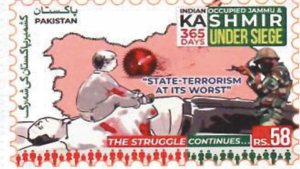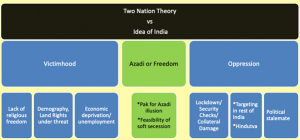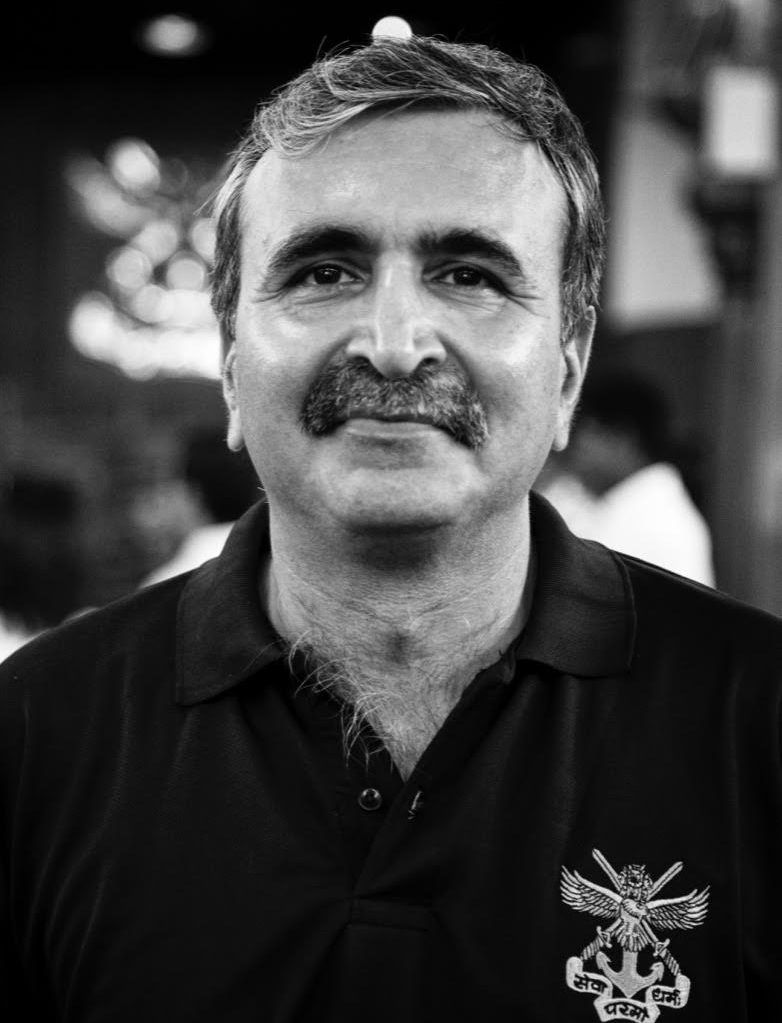
J&K Battle Of Narratives

On 6th May 23 Pakistan FM on G20 event in Srinagar said “We will respond to this in time, and they will remember it”[i]. On same day LeT/PAFF released a video statement threatening to strike at G20 meetings in Srinagar. They were blatantly on the same page!
The terror indices are down in J&K, hope of long-term peace is still fighting the fear of the radical narrative prevailing again – whispers of a subdued anger waiting to burst has been a continuous factor since Aug 2019. J&K has seen these good times only to see a bad incident giving fresh lease to radicals to once again fan the angst and terror networks. This time India and Kashmiris hope for more sustained peace. The recent terror attacks in Poonch, Rajouri only confirm that long term path to peace in J&K needs more than the development initiatives, it needs a win in the battle of narratives to deny space to separatist ideology that sustains terrorism.
Kashmir as a Case Study for Battle of Narratives
A stark example of effective prosecution of ‘battle of narratives’ by the radical eco-system is the perception about Indian Army role in stabilizing J&K. More than three decades of a conflict zone where at one stage nearly all civil arms of the state had been defeated or subverted and Insurgents or jihadis or terrorists in hundreds from Pakistan, Afghanistan and Kashmir undermined the state and society under the shadow of the gun. The power brokers of the kind of Geelani dictated who could speak and live in a state living under the shadow of Pakistan’s ISI controlled gun culture. Formal organisations like United Jihad Council, Lashkar-e-Taeba, Jaish e Mohommed, Jamaat ul Dawa and others openly canvassed for and executed ‘jihad’ or terror operations in J&K. Thousands of Hindus and Muslims migrated or were killed for not toeing the radical line.
In all this Indian Army along with J&K Police and other security forces undertook one of the world’s toughest Counter Terrorist(CT) operations to bring back the rule of law and writ of the state to an extent that J&K ranks today in top percentile of most development indices of the nation. The CT operations SOPs of Indian Army in Kashmir eschewing use of all heavy weaponry to avoid civilian collateral damage for such a long time is a lone example in the world of restraint by state forces at the cost of lives of soldiers. In comparison, the terror benefactor Pakistan is known to have used artillery, attack helicopters, drones and even fighter jets in operations like Op Zarb e Azb[ii]. However, the perception management by the JeI and Hurriyat radicals in terms of the Hurriyat calendars, complicit media groups, complicit think tanks like JKCCS, paid diaspora agents, Ktwitter etc have picked and used handful of incidents in 30 years to paint a gloomy picture of human rights violations by Indian Army and Indian state in J&K! The fact remains the propaganda effort has been effective both nationally and internationally!
The Indian Strategy
The Indian strategy in J&K has upgraded from just ‘targeting terrorists’ to ‘targeting terrorism’ as a national mission. For that, India needs to address the ‘battle of narratives’ in and about J&K as a route to lasting peace in the region.
“Understanding and engaging key audiences is meant to change perceptions, attitudes, beliefs and ultimately behaviors to help achieve military objectives as part of national objectives[iii]”. That in essence is the route to addressing insurgencies and proxy wars, as in J&K.
The Indian strategy is a multipronged whole of nation approach. It has numerous concurrent lines of operations. The assessed basic tenets are:
- Sustained intelligence-based kinetic operations to keep the upper hand on the terror network. Counter terrorist strategy includes prevention of infiltration, neutralization of existing terrorists, prevention of new terror recruitment, break the narco-terror link and break the weapon supply chain from Pakistan.
- Focus on exposing and booking the white-collar terrorists.
- No space to radicals in public space. Clear distinction between dissent and sedition. Sedition will not be tolerated.
- Focus on delivery of good governance, empower local governance structures and eradicate corruption, as means to impact common citizen.
- Focus on economic growth for citizens of J&K to harvest the peace dividend.
- Provide a secure environment for voices of peace.
- Invigorate art, culture and sports as intrinsic to J&K society.
The Indian state is conscious to avoid making the mistake of announcing victory too soon. There is awareness that the radicals have both resilience and patience for state’s mistakes to take back the narrative. It is only a battle well begun and will need sustained fleet footed execution for a longer time for peace to grow roots. The principal challenge is in the minds of the people – the battle of narratives.
Strategy of the Anti-India Cabal
The radical strategy remains the same ‘khoon se seenchege azadi’ (with blood we will sustain the independence movement); the blood would be of the poor Kashmiri caught in the cross fire between the Indian state and the terror networks. The death of the ‘cannon fodder’ youth for the terror handlers is to be used to sustain victimhood and thereby maintain the supply line. The death would follow a janaza routine to convince some more youth to become cannon fodder. This strategy has been defanged. There are no more deaths of Kashmiri civilians in crossfire, there are no more pellet gun injury victims for the photo journalists. This has seriously frustrated the radical intellectuals. One incident in Sopore in a LeT attack, death of a civilian in Jun 20 was quickly converted into a propaganda event by the radical ecosystem which ended with a Shafqat Amanat Ali song ‘Ja chod de meri wadi[iv]’ by DG ISPR and a postage stamp[v] by Pakistani state! The propaganda effort after death of a civilian in a LeT attack exposed the duplicity and complicity of the Pakistani state right up to the top national leadership.

The Façade of Azadi – The Underlying Risk
Pakistan’s internal woes and growing irrelevance as a state has obviously dented its support in J&K, however that seemingly has no impact on the separatists. Fact is that the principal slogan of even the ‘Pakistani by heart and deed’ Geelani was ‘azadi’ or independence. A call for independence resonates locally and internationally. Azadi is such an attractive word that it can resonate with youth in many parts of the world. The Pakistan aligned radical has always couched himself as a ‘freedom’ revolutionary. However, anyone who opposed the Pakistan aligned jihadi controllers was silenced by the gun of the terrorists. JKLF the first jihadi organization ceased to exist shortly after the Pakistani benefactors found out that they were looking for Azadi, in fact JKLF cadres were hunted and killed in the early 90s by the ‘local’ Hizbul Mujahideen cadres.
An international effort to reinvigorate separatism by using ‘independence’ voices from both sides of the LoC should be expected with every passing day. That is the only cloak left for the anti-India radical cabal. Expect seminars, protests at chosen sites in Europe, books, literature and academic work on this theme.
The last study on choice options for J&K citizens by a physical survey was done by Chatham House[vi] in 2009/10, the study was aimed to find a path to peace acceptable to maximum local population, the results were inconclusive indicating the challenge for the radicals in choosing a firm line. Some key questions these pseudo independence votaries will avoid answering or discussing are:
- What stops Pakistan from allowing POJK and GB (Gilgit Baltistan) to be an independent country to fight its case with India? Such a country would have greater legitimacy and international support.
- Why has Pakistan failed to give semblance of ‘azadi’ to citizens of POJK, what is status of GB in this battle for Azadi? The largely unopposed success of Pakistan in separating GB from PoJK would expose the radicals as being Pakistani stooges.
- Is there an ethnic and sectarian change in POJK and GB since 1947?
- What was the parallel of Article 370 in PoJK and GB? When were the provisions diluted by the Pakistani state?
- Why after early 90s, ISI has ensured that no radical network or voice that is not aligned to idea of joining Pakistan finds space in J&K. That was the reason, JKLF, the starter of the ‘jihad’ for azadi of J&K ceased to exist by 1995. No leader including ones like Abdul Ghani Lone survived efforts to break from the Pakistani control. Why even Geelani at death bed was disillusioned with his Pakistani benefactors.
- How would the ‘independent’ state secure its borders with Pakistan, China and most importantly Afghanistan? Last heard Iran is feeling heat from Taliban!
- What is Pakistan’s geo economic compulsion with respect to POJK and GB? Does Pakistan plan to create an independent nation with control over nearly all its water sources?
- What will be the fate of CPEC passing through the Karakoram pass in GB? What are Pakistani plans for such a situation.
In a radio interview AQ Khan on being asked about views on Azadi to Kashmir, he is said to have been candid “who toh hum unko bhalekha de rahe hain” (in that we are selling them a mirage’).
- Terror leaders like Zakir Musa of Hizbul Mujahideen wanted an Islamic State, he reasoned since the call for Jihad was from the mosques the ‘jihad’ was for a state under Islamic flag. This was not good for image of the ‘struggle’ and Zakir was disowned. No radical leader has dared to have democracy vs a theological state debate, the discussion has the capability to take the religious sting out of the indoctrination strategy.
Indians need to understand that Pakistan has a population that has been fed propaganda for 75 years about India and about J&K. While Kashmiris know what is propaganda and what real, for the Pakistani citizen propaganda comes directly from their leadership and state, and hence assumed to be true. This propaganda has kept the supply lines of JeM, LeT and others alive for so long. We have to insulate our nation from the effects till Pakistan state decides to be more truthful to its citizens. Imran Khan and Bilawal statements in international fora don’t give hope for that. There is hope from the unbridled social media and internet to change this as independent bloggers seem to have turned into story tellers across the LoC. Events like G20 in Srinagar are bad news for the propaganda machines and hence the opposition.
The Root Issue and the Propaganda Themes
It is important to correctly read the roots and manifestations of the contest in J&K. J&K is just a battle ground between the existential contest between the ‘Idea of India’ and ‘two nation theory’. J&K is neither a root cause or a solution to the larger ideological battle. The separatist ideologues publicly use principles of equality and diversity as intrinsic to J&K and then appeal for separatism as a right! The fact that the professed principles have natural affinity to the ‘Idea of India’ confuses even some Indians about the root cause. No separatist public voice has ever voiced support to the ‘two nation theory’ but have always acted in ways that reveals the basic ideology which is opposed to multi-religious society. Syed Geelani was most duplicitous on this and earned invites from Indian intelligentsia keen to understand the root cause.
This root cause is couched in three principle themes of victimhood, mirage of azadi and cries of oppression. The table below covers some of the themes that are used to feed dissent, separatism, radicalization and terrorism.

The lies have to be called out by facts on each element in formats as digested by the national and international audience. That is the ‘battle of narratives’ lines of operation of the Indian state. This would have to be a whole of nation approach with the Academia, Think-tanks, society and the state joining hands to build a better secure future of J&K and the Indian nation. J&K cannot be allowed to remain the battle ground for the Pakistani obsession with a dysfunctional ideology that has made it a hotbed of terror and violence of all that stay in its boundaries or neighborhood. After targeting minorities of other religion, the Pakistani ideology is now targeting sects within Islam. The residual terror ecosystem has taken off the fig leaf over the radical intent by targeting the few left over Kashmiri Pandits in the valley.
The finals steps for long term peace in Kashmir would need a continued win in kinetic operations and an emphatic win in this battle of narratives. India has already woken up to the challenge, she has to dig its heels deep for a long haul to regain space from the radicals.
*******************************************************************************************************************************
The views expressed and suggestions made in the article are solely of the author in personal capacity and do not have any official endorsement. Attributability of contents lies purely with the author.
*******************************************************************************************************************************
References:
[i] https://economictimes.indiatimes.com/news/india/did-pakistan-fm-bilawal-bhutto-try-damage-control-backtracks-from-his-threatening-statement-on-srinagar-g20-mee/videoshow/100054789.cms
[ii] https://www.refworld.org/docid/55a4cfa74.html
[iii] Murphy, Dennis. The Trouble of SC(S). CSL, 2008
[iv] https://www.youtube.com/watch?v=gyXZceFllmU
[v] http://commonwealthstampsopinion.blogspot.com/2020/08/1713-pakistans-latest-philatelic-shot.html
[vi]https://www.chathamhouse.org/sites/default/files/public/Research/Asia/0510pp_kashmir.pdf
Disclaimer
The opinions expressed in this article are the author’s own and do not reflect the views of Chanakya Forum. All information provided in this article including timeliness, completeness, accuracy, suitability or validity of information referenced therein, is the sole responsibility of the author. www.chanakyaforum.com does not assume any responsibility for the same.
Chanakya Forum is now on . Click here to join our channel (@ChanakyaForum) and stay updated with the latest headlines and articles.
Important
We work round the clock to bring you the finest articles and updates from around the world. There is a team that works tirelessly to ensure that you have a seamless reading experience. But all this costs money. Please support us so that we keep doing what we do best. Happy Reading
Support Us





















POST COMMENTS (0)